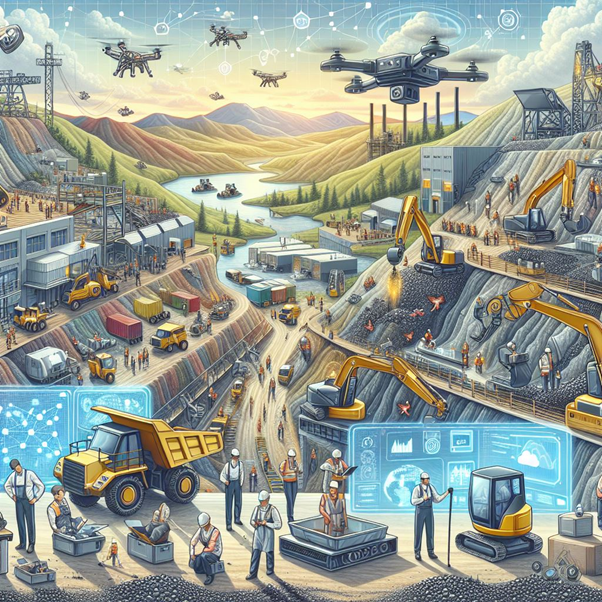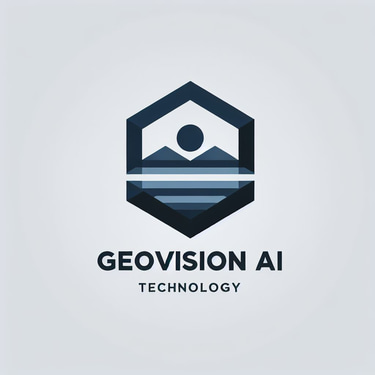How AI Technology Will Transform the Mining Industry Paradigm
Xuan-Ce Wang
2/3/20257 min read
Summary
Artificial intelligence (AI) is set to revolutionize the mining industry, fundamentally transforming operations, enhancing safety, and promoting sustainability. As the sector faces increasing pressures from rising operational costs, regulatory scrutiny, and environmental concerns, AI offers innovative solutions to streamline processes and optimize resource management. This shift not only improves efficiency and reduces emissions but also marks a transition from traditional labour-intensive practices to more automated and data-driven methodologies.
AI applications in mining include predictive maintenance, which minimizes equipment failures and associated costs, as well as real-time environmental monitoring to improve resource management. Companies are increasingly adopting AI-powered autonomous machinery, computer vision, and advanced data analytics to enhance productivity and safety while ensuring compliance with stringent environmental regulations [1][2][3]. However, the transition to AI-driven operations presents challenges, such as the need for substantial investment in technology, workforce training, and navigating a complex regulatory landscape.
The potential for AI to enhance sustainability in mining is particularly significant, given the industry’s contribution to global greenhouse gas emissions, which account for approximately 4% to 7% of total emissions [3]. By optimizing energy consumption and implementing innovative practices such as biomining and automated water management, AI can help the industry significantly reduce its environmental footprint. However, mining companies must also contend with socio-economic and geopolitical factors that impact resource access and operational viability [4][5].
As the mining industry increasingly embraces AI technologies, it faces both opportunities and challenges that will shape its future. Balancing the promise of increased productivity and safety with the complexities of technological adoption, workforce development, and environmental stewardship will be crucial in navigating this transformative era [6][7].
1. Introduction
The mining industry plays a critical role in the global economy, contributing essential raw materials for construction, manufacturing, and energy sectors. However, the industry faces several challenges: rising operational costs, environmental sustainability concerns, and increased regulatory scrutiny [1][4]. These issues are creating significant pressure on companies to innovate and adopt advanced technologies, such as artificial intelligence (AI), to modernize operations, reduce costs, and improve sustainability.
The integration of AI in mining has already begun to reshape the sector. According to a report by the International Council on Mining and Metals (ICMM), AI adoption could boost productivity by up to 20% while significantly reducing environmental impacts and improving safety [2]. As such, understanding the role of AI in overcoming these challenges is key to shaping the future of the mining industry.
2. Challenges in the Mining Industry
2.1 Rising Operational Costs
In 2023, mining companies saw an increase in operational costs, especially energy consumption, equipment maintenance, and labor costs. According to a study by McKinsey & Company, energy costs alone account for 20-30% of total operational expenses in large-scale mining operations [4]. With energy consumption expected to rise by 25% over the next decade, there is an urgent need for innovative solutions like AI to optimize operations and reduce waste.
2.2 Safety Risks
Mining continues to be one of the most dangerous industries, with fatality rates significantly higher than many other sectors. For example, in 2020, the mining industry had a fatal injury rate of 6.8 per 100,000 workers, compared to an average of 3.3 per 100,000 for all private industries in the United States [5]. AI applications in safety, such as autonomous drones for site inspection and real-time hazard detection systems, aim to reduce these risks. The integration of AI-driven safety measures has the potential to cut accident rates by up to 40%, according to research by Deloitte [6].
2.3 Environmental and Regulatory Pressures
Mining contributes significantly to environmental degradation, including deforestation, water pollution, and greenhouse gas emissions. The sector accounts for around 7% of global carbon emissions, making it one of the largest industrial contributors to climate change [3]. Governments worldwide have introduced stricter environmental regulations, and the push for greener practices is growing stronger. For instance, the European Union's "Green Deal" aims to reduce carbon emissions to net zero by 2050, with mining being a critical focus area for emissions reduction [7].
3. Technological Integration: The Role of AI and Machine Learning
3.1 AI in Mining Operations
AI has begun to revolutionize mining by increasing operational efficiency and reducing environmental impact. Key areas where AI is being integrated include:
Predictive Maintenance: AI-powered predictive maintenance systems analyze sensor data from equipment to forecast failures before they occur, preventing costly downtime. For example, Rio Tinto has seen a 10-20% reduction in maintenance costs and a 50% reduction in unplanned downtime by implementing AI-based predictive maintenance [8].
Real-Time Environmental Monitoring: Real-time data collected from AI-powered sensors allows companies to monitor environmental conditions such as air quality, water consumption, and energy usage. AI systems can then suggest adjustments to optimize resource use and ensure compliance with environmental standards. Anglo American, for instance, reduced water consumption by 10-15% using AI-driven water management systems at its operations in Chile [9].
3.2 Automation and Shift from Traditional Methods
AI is facilitating the shift from labor-intensive, traditional mining methods to more automated, data-driven processes. Autonomous haul trucks and drilling equipment are now common at large mining sites. For instance, BHP’s autonomous haulage system has operated for over 10 million hours, improving efficiency and reducing human error. AI enables autonomous machinery to operate 24/7, minimizing downtime and human risk in hazardous environments [10].
The total investment in autonomous mining trucks and equipment is expected to reach $4.4 billion by 2025, according to a report by Markets and Markets [11].
3.3 Infrastructure and Workforce Investment
Adopting AI requires significant infrastructure investment, as well as the training of personnel to manage new systems. A report by Accenture indicates that while AI adoption costs can be high—estimated at around $500 million for large-scale operations—the return on investment (ROI) can be up to 30% over a 5-year period [12].
4. Environmental and Sustainability Concerns
4.1 Mining’s Environmental Impact
Mining operations contribute significantly to environmental damage. For example, the extraction of metals like gold and copper generates large amounts of waste, with a single gold mine producing up to 1.5 million tons of waste annually [13]. The energy-intensive nature of mining, coupled with the use of hazardous chemicals, exacerbates environmental degradation.
To address these challenges, mining companies are turning to AI to optimize energy use and minimize waste. For instance, Barrick Gold’s energy optimization system, powered by AI, has reduced its carbon emissions by over 5,000 tons annually by optimizing its operations [14].
4.2 AI-driven Sustainability Initiatives
AI is playing a critical role in driving sustainability initiatives. A study by the World Economic Forum found that AI could reduce global mining emissions by 15%, primarily through the optimization of energy use and water management [15].
Biomining: AI enables the use of microorganisms for the extraction of metals, a process that has a much lower environmental impact than traditional methods. Research from the University of Queensland has shown that biomining could reduce the need for toxic chemicals by up to 90% while improving resource recovery rates by 20% [16].
Water Management: AI-powered water recycling systems are reducing the mining sector’s water footprint. For example, a system implemented at Teck Resources' coal mine in Canada uses AI to optimize water treatment processes, saving an estimated 12 million liters of water per year [17].
5. The Role of AI in Enhancing Operational Efficiency
5.1 Enhancing Productivity
AI technologies significantly enhance productivity in mining operations by reducing equipment downtime, optimizing haulage routes, and automating manual tasks. Autonomous trucks, for instance, can increase transport efficiency by 15-20%, while AI-driven sorting systems can improve ore recovery rates by 5-10% [18].
5.2 Predictive Maintenance
Predictive maintenance powered by AI is a game changer in the mining sector. According to the Maintenance Association of Canada, predictive maintenance can reduce equipment failure rates by up to 50% and increase operational uptime by 10-20% [14]. This has far-reaching implications for operational efficiency and cost savings.
5.3 Resource Management
AI systems can analyze geological data to predict ore grades and identify the most productive mining sites. For instance, AI has helped companies like Goldspot Discoveries improve the accuracy of resource identification by 30%, reducing exploration costs and time [2].
6. Case Studies: AI in Action
6.1 BHP – Predictive Maintenance
BHP has implemented AI-driven predictive maintenance to monitor the health of its mining equipment in real time. This technology has reduced unplanned downtime by 50%, saving the company millions in repair costs and improving overall operational efficiency [16][17].
6.2 Barrick Gold – Geological Data Analysis
Barrick Gold’s adoption of AI for geological data analysis has allowed the company to identify prospective mining sites with greater accuracy. AI systems have reduced exploration time by 25%, cutting costs and improving resource identification [16][18].
6.3 Rio Tinto – Autonomous Haulage System
Rio Tinto’s autonomous haulage system has significantly improved efficiency and safety. By removing human drivers from hazardous environments, Rio Tinto has seen a 15% increase in productivity and a 10% reduction in operational costs [16][19].
6.4 Almonty Industries – Mine Safety
Almonty Korea Tungsten Corp partnered with Korea Telecom to implement AI-powered mine safety systems. This collaboration has helped improve worker safety and environmental responsibility at the Sangdong mine, which is one of the world’s largest tungsten mines [18].
7. Future Trends in AI and Mining
7.1 Emerging AI Technologies
As AI technologies evolve, the convergence with other emerging technologies such as blockchain, 5G, and IoT will revolutionize the mining industry. For instance, AI-driven multi-agent systems, in combination with IoT, will facilitate decentralized decision-making, improving operational efficiency and transparency [19].
7.2 Collaboration with Regulatory Bodies
AI will play a key role in ensuring mining companies comply with environmental regulations. Real-time monitoring powered by AI can track emissions, water usage, and waste disposal, ensuring that companies meet global sustainability standards [13].
7.3 Environmental Sustainability
AI will continue to be integral to the mining industry's sustainability efforts. Research by the World Economic Forum suggests AI could lead to a 15% reduction in global mining emissions, contributing significantly to environmental goals [22].
8. Conclusion and Challenges Ahead
While AI presents numerous opportunities for the mining sector, challenges remain, including high initial costs, data quality issues, and the need for skilled personnel. However, the growing adoption of AI technologies, particularly in predictive maintenance, resource management, and environmental sustainability, will reshape the industry’s future. As AI systems become more sophisticated, mining companies must focus on overcoming these challenges to fully realize the potential of AI in transforming mining operations.
References
[1] Digging Deeper: Machine Learning and AI Applications in Mining - Kitameraki
[2] The Impact of AI on the Global Mining Economy - LinkedIn
[3] Current & Future Role of AI in Mining - kimiaholding.com
[4] The impact of AI on the mining sector - Mine | Issue 145 | October 2024
[5] The Role of Technology in Mining Safety and Environmental Protection
[6] Top 10 Mining Industry Trends & Innovations | StartUs Insights
[7] 7 Cutting-Edge Applications of AI in Mining for 2025 - Viso
[8] The Role of AI in Sustainable Mining: A Path to a Greener Future - LinkedIn
[9] AI in the Mining Industry: From Ore to Optimization
[10] Artificial Intelligence's Impact on Mining: AI is Revolutionizing the ...
[11] Artificial Intelligence's Impact on Mining: AI is - GlobeNewswire
[12] Transforming the Mining Sector: An In-Depth Analysis of AI ... - LinkedIn
[13] Embracing AI And Emerging Technologies Can Help Transform The Mining ...
[14] Predictive Maintenance and the Rise of AI in Mining
[15] Predictive maintenance and the rise of AI in mining
[16] AI Transformation Chronicles: AI in Mining Industry - Digitopia
[17] Behind the mining technology transformation | McKinsey
[18] Case studies: AI in mining - Mine | Issue 145 | October 2024
[19] Driving AI Innovation and Sustainability in Mining [20]: How AI is being integrated into the mining industry
[21] How AI tackles productivity challenges in mining
[22] The Role of Technology in Mining Safety and Environmental Protection










